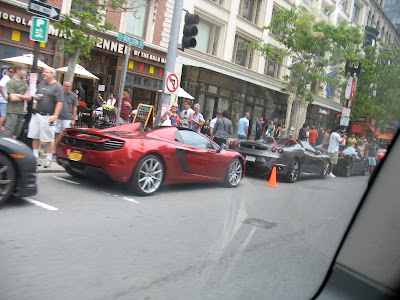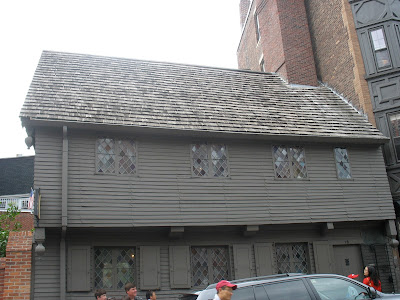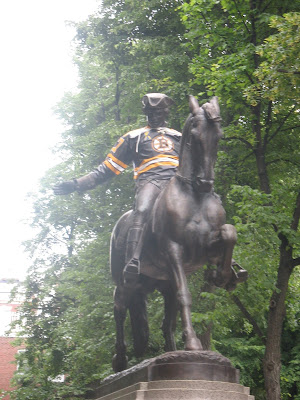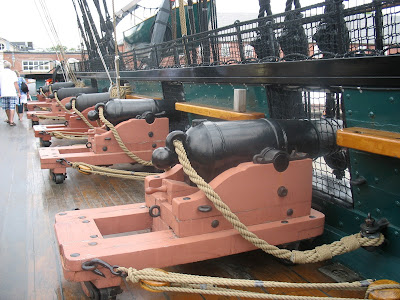"And here's to good old Boston
The land of the bean and the cod
Where Lowells talk only to Cabots
and Cabots talk only to God."
While driving in Boston we passed what looked like a Ferrari convention - millions of dollars worth of car-flesh in a couple of blocks.
This is Hancock Tower. I have a great memory of Hancock Tower. When Karl and I lived in Boston many years ago, we were out walking one misty night and waiting to cross the street. I looked up behind me and saw this incredibly tall building disappearing into the clouds. We looked at each other and we both knew without saying anything that we had to get to the top of it. So we did, and found a really cool model of the city at the top.
This is Faneuil Hall. You really want to eat at Faneuil Hall in Boston. It's a giant food court. But it didn't used to be. Faneuil Hall has been a marketplace and a meeting hall since 1742. It was the site of several speeches by Samuel Adams, James Otis, and others encouraging independence from Great Britain. It is sometimes referred to as "the Cradle of Liberty."
When Karl and I lived in Boston, our absolute favorite place was the Haymarket Farmer's Market. Every Saturday we took $30 out of the bank and bought our groceries for the week. There was a grimy meat market below stairs, a cheese seller who used to stand out front of his shop with a sizzling pan barking "SAUsages!" and every fruit and vegetable you can imagine. Burly Italian sellers would shout at little Asian ladies for squeezing the produce. When we finished shopping, we always got slices of pizza which we ate standing up at sawhorse tables.
Boston, with its abundance of historical sites, has created "The Freedom Trail," a tour of the city that you can follow by walking along a red line in the pavement.
This is Paul Revere's house.
This, of course, is Paul Revere, and because the Boston Bruins hockey team are in the playoffs (or something like that), he's wearing a shirt. And that's history - the new layered over the old in a splinchy montage.
The Old North Church. You know what happened here, right? You really should read this splendid poem before going on. It was on my mind all day:
"One if by land and two if by sea,
and I on the opposite shore will be,
Ready to ride and spread the alarm
Through every Middlesex village and farm,"
In the church, patrons rent pew boxes, in which their family sits during the service. The pew can be decorated however you like, and little metal heaters are used to keep warm.
We came across a few living historians along the trail. This man is a printer and he told us all about printing in Boston during the Revolution. He can print 2,000 copies a day. It takes several days to set up print for one page, because it's done letter-by-letter. Today he's printing contracts for indentured servants. At about 12 years of age, many boys were put into service for seven years to learn a trade.
We also met a lady making chocolate. Not the kind you eat; but drinking chocolate. You roast cocoa beans, then grind them and remove the chaff, then grind the nibs in this pestle, along with some of the spices shown, such as orange peel, cinnamon, nutmeg, anise, or salt, and when mixed with an equal amount of hot water, and some sugar, you get a very rich hot chocolate drink. I bought a block of it to try out at Civil War events. The copper pot, which mixes the chocolate, is like a mini butter churn.
Next we came to the Bunker Hill monument, where the Battle of Bunker Hill was fought. (It's actually on Breed's Hill, but never mind about that.)
The Battle of Bunker Hill took place on June 17, 1775, mostly on and around Breed's Hill, during the Siege of Boston early in the American Revolutionary War. On June 13, 1775, the leaders of the colonial forces besieging Boston learned that the British generals were planning to send troops out from the city to occupy the unoccupied hills surrounding the city. In response to this intelligence, 1,200 colonial troops under the command of William Prescott stealthily occupied Bunker Hill and Breed's Hill, constructed an earthen redoubt on Breed's Hill, and built lightly fortified lines across most of the Charlestown Peninsula.
When the British were alerted to the presence of the new position the next day, they mounted an attack against them. After two assaults on the colonial lines were repulsed with significant British casualties, the British finally captured the positions on the third assault, when the defenders in the redoubt ran out of ammunition. The colonial forces retreated to Cambridge.
While the result was a victory for the British, they suffered heavy losses: over 800 wounded and 226 killed, including a notably large number of officers. Colonial forces were able to retreat and regroup in good order having suffered fewer casualties. Furthermore, the battle demonstrated that relatively inexperienced colonial forces were willing and able to stand up to regular army troops in a pitched battle.
Do you know who Dr. Joseph Warren was? You probably don't, but only because he died at Bunker Hill. Had he lived, he would undoubtedly be revered as one of our Founding Fathers. Dr. Joseph Warren (June 11, 1741 – June 17, 1775) was an American doctor who played a leading role in American Patriot organizations in Boston in early days of the American Revolution, eventually serving as president of the revolutionary Massachusetts Provincial Congress. Warren enlisted Paul Revere and William Dawes on April 18, 1775, to leave Boston and spread the alarm that the British garrison in Boston was setting out to raid the town of Concord and arrest rebel leaders John Hancock and Samuel Adams. Warren participated in the next day's Battles of Lexington and Concord, which are commonly considered to be the opening engagements of the American Revolutionary War.
Warren had been commissioned a Major General in the colony's militia shortly before the June 17, 1775 Battle of Bunker Hill. Rather than exercising his rank, Warren served in the battle as a private soldier, and was killed in combat when British troops stormed the redoubt atop Breed's Hill. His death, immortalized in John Trumbull's painting, The Death of General Warren at the Battle of Bunker's Hill, June 17, 1775, galvanized the rebel forces, and he has been memorialized in many place names in the United States.
We also visited the USS Constitution, a wooden-hulled, three-masted heavy frigate of the United States Navy. Named by President George Washington after the Constitution of the United States of America, she is the world's oldest commissioned naval vessel afloat. Launched in 1797, Constitution was one of six original frigates authorized for construction by the Naval Act of 1794 and the third constructed. Joshua Humphreys designed the frigates to be the young Navy's capital ships, and so Constitution and her sisters were larger and more heavily armed and built than standard frigates of the period. Built in Boston, Massachusetts, her first duties with the newly formed United States Navy were to provide protection for American merchant shipping during the Quasi-War with France and to defeat the Barbary pirates in the First Barbary War. The Constitution is most famous for her actions during the War of 1812 against Great Britain, when she captured numerous merchant ships and defeated five British warships. She is nicknamed "Old Ironsides."
Brennan, in front of the Green Dragon tavern.
We lucked out on hotels. In seeking somewhere inexpensive, we got a deal at Nantasket Beach Resort.
This was the view from our balcony. I went for a long run on the beach the next day, (and wanted a nap all day as a consequence.)

























No comments:
Post a Comment